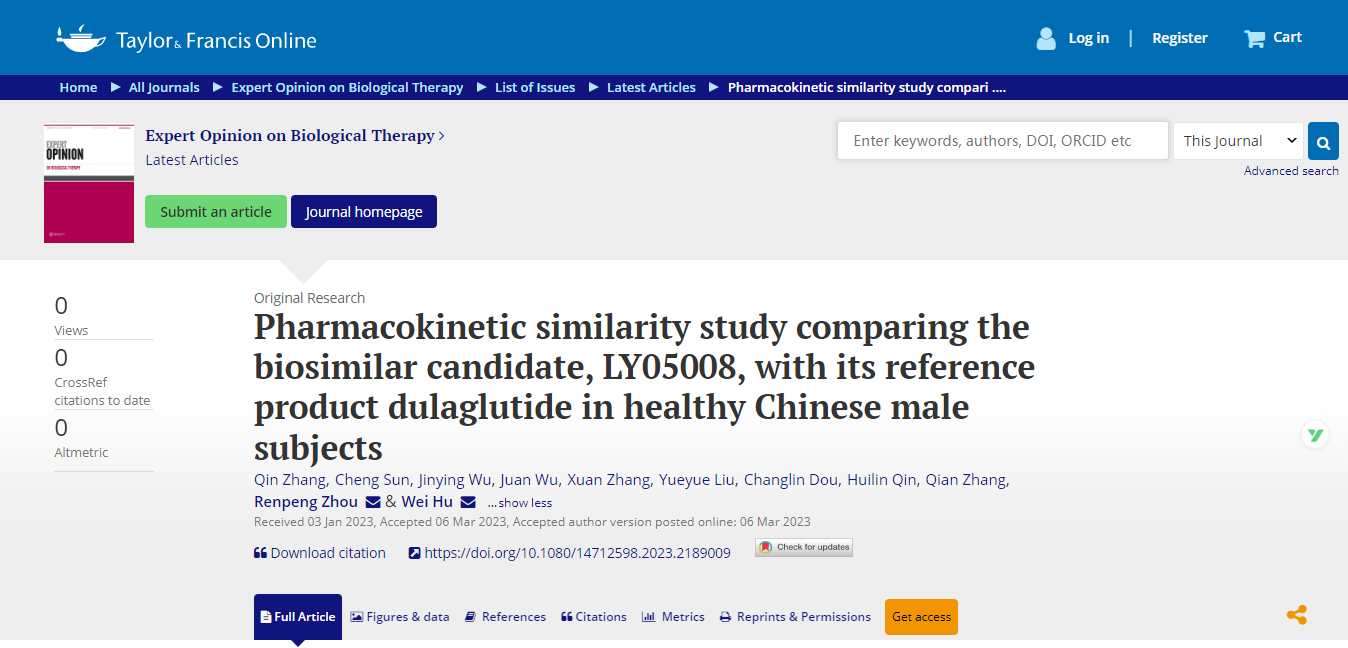
Recently, the results of the phase 1 clinical study of Dulaglutide Injection (BA5101, formerly coded LY05008) , a biosimilar of Trulicity® solely developed by Boan Biotech, were published in the journal of Expert Opinion on Biological Therapy (impact factor: 5.589), Taylor & Francis. The results of the phase 1 clinical study showed that BA5101 and Trulicity® have similar PK properties as well as comparable safety and immunogenicity profiles, which demonstrated biological similarity of BA5101 to Trulicity®.

The primary investigator of this study was professor Hu Wei from the Drug Clinical Trial Research Center of The Second Hospital of Anhui Medical University. This equivalence study was designed as a single-center, randomized, open-label, parallel-group, single-dose, positive controlled study to compare the PK, safety and immunogenicity profiles of BA5101 withTrulicity® in male healthy Chinese volunteers.
Subjects were randomly assigned 1:1 to receive either BA5101 or Trulicity® subcutaneously. The study met all primary endpoints, AUC0-∞, AUC0-t and Cmax of BA5101 and Trulicity® were all within the bioequivalence limits, while other PK parameters, safety and immunogenicity profiles were also comparable across the two groups, demonstrating that BA5101 is highly similar to Trulicity®.
Type 2 diabetes mellitus (T2DM) is a chronic and metabolic disease characterized by elevated levels of blood glucose primarily due to insufficient insulin secretion and/or insulin resistance, which is the majority type of diabetes mellitus. With the improvement of economic condition and the change of life style, the prevalence of diabetes mellitus in Chinese people has been increasing year by year, of which type 2 diabetes accounts for more than 90% of the disease.
The complications of type 2 diabetes are the most important factors affecting the quality of life and even the survival of patients. Aside from acute complications such as hypoglycemia and ketoacidosis, chronic complications of diabetes including microvascular and macrovascular diseases are important causes of disability and death. Furthermore, type 2 diabetes patients are often exposed to other risk factors for metabolic diseases and cardiovascular diseases, such as hypertension, hyperlipidemia, obesity, etc., which increases the risk of complications, affects the quality of life and health of the patients, and may also bring heavy burden to the patients' family and the society. [1]
According to the latest data released by the International Diabetes Federation (IDF), 537 million (10.5%) adults aged 20-79 had diabetes in 2021, namely 1 in 10 people had diabetes mellitus. The total number of diabetes mellitus worldwide is expected to increase to 643 million (11.3%) by 2030, 783 million (12.2%) by 2045, and 174 million people will have diabetes in China by 2045. [2]
Dulaglutide is a long-acting glucagon-like peptide-1 (GLP-1) receptor agonist with approximately 90% amino acid sequence homology to natural human GLP-1 (7-37). Different from natural GLP-1, dulaglutide is less prone to degradation by DPP-4 and has a larger molecular weight, which can slow down the absorption and reduce the renal clearance. In response to elevated glucose levels, dulaglutide increases cyclic adenosine monophosphate (cAMP) level in pancreatic beta cells and promotes insulin release. Dulaglutide also inhibits glucagon secretion, thus reducing hepatic glucose output. In addition, dulaglutide delays gastric emptying.
Correspondingly, dulaglutide can significantly reduce the risk of major cardiovascular events in patients with confirmed coronary atherosclerotic heart disease and patients with cardiovascular risk factors. Dulaglutide injection is administered once a week for blood sugar control in adults with type 2 diabetes. Compared with other glucose-lowering drugs, dulaglutide injection can effectively control blood glucose and HbA1c levels while simultaneously improving control of multiple risk factors for cardiovascular diseases such as weight gain and hyperlipidemia, and lower the hypoglycemia rate. By virtue of the characteristics of better safety and convenience of use, dulaglutide has broad market applications worldwide with global sales of 7.44 billion US dollars in 2022.
Dulaglutide is a fusion protein that consists of 2 identical, disulfide-linked chains, each containing an modified GLP-1 analog sequence covalently linked to the Fc portion of a human immunoglobulin G4 (IgG4) heavy chain by a small peptide linker. The development of its biosimilars has higher technical hurdles, especially due to the percentage of oxidation, truncation and charge variants of the fusion protein molecules must be controlled to be highly similar to the reference product.
The development of BA5101 was conducted in accordance with related guidelines for biosimilar by Boan Biotech. The finished preclinical head-to-head comparative studies show that BA5101 is highly similar to Trulicity® in terms of physicochemical and functional properties. The results of the Phase 1 clinical study demonstrated a high degree of similarity in pharmacokinetic profiles.
Currently, Boan Biotech is conducting a randomized, open-label, parallel-group, positive controlled phase 3 study to compare the efficacy and safety between BA5101 and Trulicity® in Chinese adults with type 2 diabetes. As the first candidate to enter the phase 3 clinical trial in China, BA5101 is expected to become the first biosimilar of dulaglutide to be marketed for providing a high-quality and affordable option for Chinese patients with T2DM. Boan Biotech will accelerate the overseas IND application and clinical development of BA5101 in order to benefit the global patients in the future.
Type 2 diabetes mellitus (T2DM) is a chronic and metabolic disease characterized by elevated levels of blood glucose primarily due to insufficient insulin secretion and/or insulin resistance, which is the majority type of diabetes mellitus. With the improvement of economic condition and the change of life style, the prevalence of diabetes mellitus in Chinese people has been increasing year by year, of which type 2 diabetes accounts for more than 90% of the disease.
The complications of type 2 diabetes are the most important factors affecting the quality of life and even the survival of patients. Aside from acute complications such as hypoglycemia and ketoacidosis, chronic complications of diabetes including microvascular and macrovascular diseases are important causes of disability and death. Furthermore, type 2 diabetes patients are often exposed to other risk factors for metabolic diseases and cardiovascular diseases, such as hypertension, hyperlipidemia, obesity, etc., which increases the risk of complications, affects the quality of life and health of the patients, and may also bring heavy burden to the patients' family and the society. [1]
According to the latest data released by the International Diabetes Federation (IDF), 537 million (10.5%) adults aged 20-79 had diabetes in 2021, namely 1 in 10 people had diabetes mellitus. The total number of diabetes mellitus worldwide is expected to increase to 643 million (11.3%) by 2030, 783 million (12.2%) by 2045, and 174 million people will have diabetes in China by 2045. [2]
Dulaglutide is a long-acting glucagon-like peptide-1 (GLP-1) receptor agonist with approximately 90% amino acid sequence homology to natural human GLP-1 (7-37). Different from natural GLP-1, dulaglutide is less prone to degradation by DPP-4 and has a larger molecular weight, which can slow down the absorption and reduce the renal clearance. In response to elevated glucose levels, dulaglutide increases cyclic adenosine monophosphate (cAMP) level in pancreatic beta cells and promotes insulin release. Dulaglutide also inhibits glucagon secretion, thus reducing hepatic glucose output. In addition, dulaglutide delays gastric emptying.
Correspondingly, dulaglutide can significantly reduce the risk of major cardiovascular events in patients with confirmed coronary atherosclerotic heart disease and patients with cardiovascular risk factors. Dulaglutide injection is administered once a week for blood sugar control in adults with type 2 diabetes. Compared with other glucose-lowering drugs, dulaglutide injection can effectively control blood glucose and HbA1c levels while simultaneously improving multiple risk factors for cardiovascular diseases such as weight gain and hyperlipidemia, and lower the hypoglycemia rate. By virtue of the characteristics of better safety and convenience of use, dulaglutide has broad market applications worldwide with global sales of 7.44 billion US dollars in 2022.
Dulaglutide is a fusion protein that consists of 2 identical, disulfide-linked chains, each containing an modified GLP-1 analog sequence covalently linked to the Fc portion of a human immunoglobulin G4 (IgG4) heavy chain by a small peptide linker. The development of its biosimilars has higher technical hurdles, especially due to the percentage of oxidation, truncation and charge variants of the fusion protein molecules must be controlled to be highly similar to the reference product.
The development of BA5101 was conducted in accordance with related guidelines for biosimilar by Boan Biotech. The finished preclinical head-to-head comparative studies show that BA5101 is highly similar to Trulicity® in terms of physicochemical and functional properties. The results of the Phase 1 clinical study demonstrated a high degree of similarity in pharmacokinetic profiles.
Currently, Boan Biotech is conducting a randomized, open-label, parallel-group, positive controlled phase 3 study to compare the efficacy and safety between BA5101 and Trulicity® in Chinese adults with type 2 diabetes. As the first candidate to enter the phase 3 clinical trial in China, BA5101 is expected to become the first biosimilar of dulaglutide to be marketed for providing a high-quality and affordable option for Chinese patients with T2DM. Boan Biotech will accelerate the overseas IND application and clinical development of BA5101 in order to benefit the global patients in the future.
References:
[1] Center for Drug Evaluation, National Medical Products Administration (NMPA). Technical guidance for clinical research and development of drugs for type 2 diabetes mellitus in adults. 2023.2
[2] Factsheets with global and regional data from the IDF Diabetes Atlas 10th Edition. https://diabetesatlas.org/regional-factsheets
